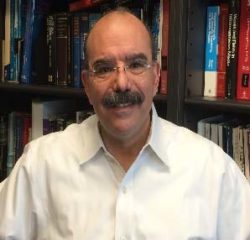
Dr. John L. Volakis
Florida International University
Monday, December 4, 2017
5:00PM – 6:00PM – HEC 113
Abstract
Future communication links will require higher data rates, multiple beams, and higher transmit/receive gains, in addition to smaller weight, cost, and power. With the growing interest for reduced size platforms and the requirement for ultra-wideband (UWB) performance to address multi-functionality, there is a strong need for UWB apertures to enable increased spectral efficiency, multi-functionality and security, there is a strong need for small UWB apertures, particularly at millimeter wave frequencies. Such apertures enable increased spectral efficiency, spatial multiplexing, concurrent beams at different frequencies. Furthermore, UWB arrays offer high data rates and allow for secure communication using long codes that spread across the bandwidth. An added feature will be the capability for simultaneous transmit and receive (STAR) applications.
In addition to challenges in designing small size UWB arrays, traditional antenna arrays are associated with complex electronic back-end that are typically associated with large power requirements. For UWB arrays, beamforming should also be frequency independent. However, to date, there is no technology for low power and small form factor wideband beamforming. In fact, traditional beam-formers are mostly suited for narrowband or multiband operation with inherently high power requirements.
This presentation will review traditional beamforming approaches, and presents innovative methods for handling UWB communications. We anticipate that a combination of UWB array with OSCDM coding and autonomous beamforming mechanisms will lead to game-changing frequencyindependent down-conversion, beam steering and MIMO across large bandwidths, from MHz to millimeter wave bands. At the conference, we will discuss system evaluation and performance of these concepts using
simulations and model measurements.
Biography
Volakis is the Dean at the College of Engineering and Computing at Florida International Univ (FIU), and a Professor in the Electrical and Computer Engineering Dept. He is an IEEE and ACES Fellow. Prior to coming to FIU, he was the Roy and Lois Chope Chair in Engineering at Ohio State and a Professor in the Electrical and Computer Engineering Dept. (2003-2017). He also served as the Director of the Ohio State Univ. ElectroScience Laboratory for 14 years (with approx. 30 faculty/researchers).
His career spans 2 years at Boeing, 19 years on the faculty at the Univ of Michigan and 15 years at Ohio State. At Michigan he served as the Director of the Radiation Laboratory at U of Michigan (1998-2000). He has 35 years of experience and his research covers wireless communications, wearable textile antennas and electronics, antenna and arrays, ultra-wideband RF beamforming techniques, RF materials and metamaterials, EMI/EMC, multi-physics engineering, bioelectromagnetics, mm-wave front ends for GB communications, THz, radar scattering, RF systems integration, propagation, design optimization, and computational methods. He is internationally known for introducing hybrid finite element methods in electromagnetics, antenna miniaturizations techniques and textile electronics. In 2004, he was listed by ISI among the top 250 highly cited scientists/engineers. His publications include 8 widely used books, 400 journal papers and nearly 800 conference papers. As of May 2017, his google h-index=59 with nearly 16000 citations. He mentored nearly 90 Ph.Ds with 37 of them having won awards at international conferences.